The shrimp farming business has become a very profitable and competitive business. Shrimp farming is raising shrimp in a controlled environment (an indoor or outdoor tank, raceway, or pond) so they are not allowed to breed and develop naturally.
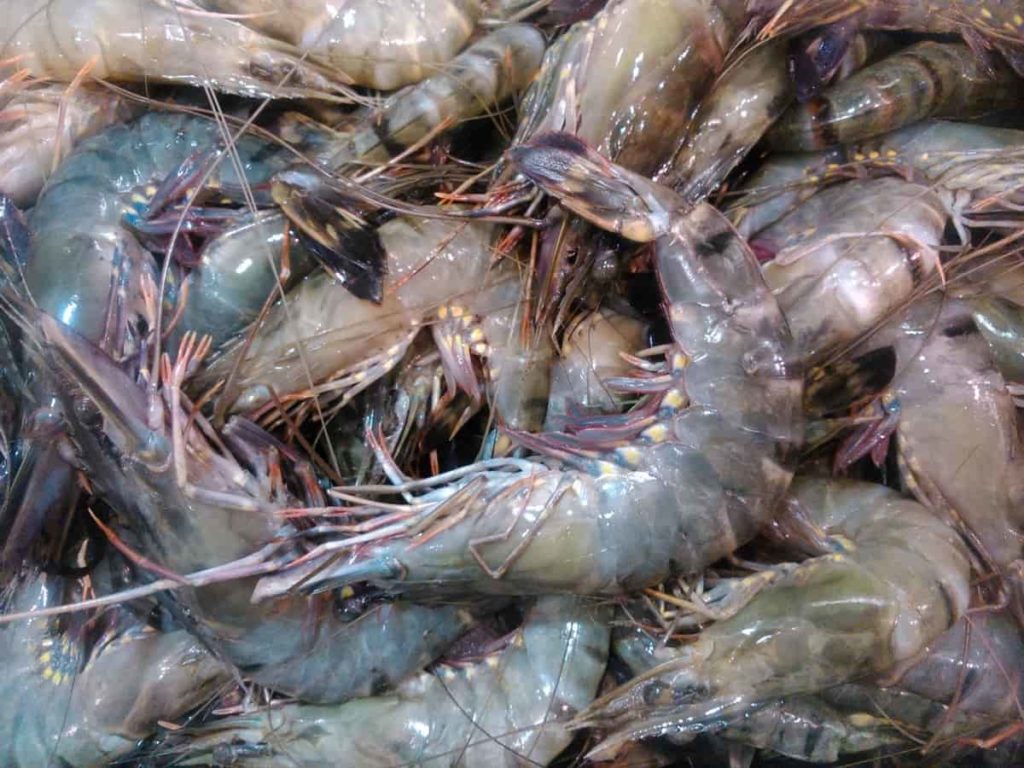
How to start Shrimp/Prawn farming from scratch
How do I start a shrimp farm?
1. Design the shrimp farm – A farm should be designed with a size of 0.4 – 0.5 hectares, and preferably the drainage system should be organized accordingly. The design, elevation, and orientation of aqueducts should be related to the area’s elevation with particular reference to the average range of tidal fluctuations. Ponds should generally have concrete decks, elevated concrete supply canals with separate drain gates, and adequate life support equipment such as generators and aerators.
2. Obtain the appropriate business licenses and permits to operate a freshwater shrimp farm in your state. Most states require shrimp farmers to have an aquaculture permit. You can purchase these permits from your state’s Department of Agriculture.
3. Reserve a location to raise your shrimp. Most farmers use ponds. However, this is not a requirement. Swimming pools, tanks, and other containers of significant depth are suitable containers for raising freshwater shrimp. However, they do not give the best results. For a large population of healthy crustaceans, a pond is more suitable.
In case you missed it: 16 Key Rules for Effective Shrimp/Prawn Farm Management: From Planning to Reduce Production Cost
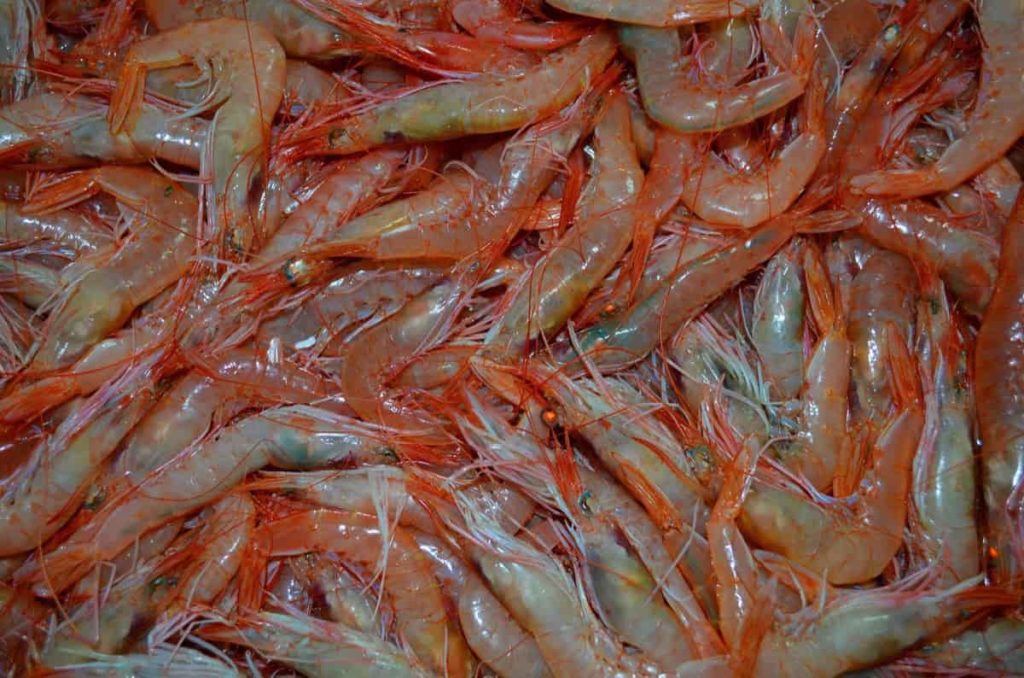
4. Test the water before adding the shrimp. Water should be free of chemicals and harmful bacteria.
5. Add the aerator to the water – For the shrimp to survive and reproduce, the aerator must run 24 hours a day while rearing.
6. Buy quality juvenile shrimp – Shrimp hatcheries typically sell juveniles for a few cents per shrimp. The price will vary by the hatchery.
What are the different kinds of shrimp farms?
There are many shrimp farms available in the world. Some shrimp farms are large-scale commercial farms, while others are small family operations. The farm type depends on the climate, water availability, and type of shrimp. There are mainly three types of shrimp farms:
- Traditional ponds
- Intensive ponds and
- Raceways
Traditional ponds use natural bodies of water such as rivers or lakes. Intensive ponds are enclosed in cages or tanks and use recirculated water. Raceways are long, narrow passages that allow for better circulation of water. Some shrimp species do better in conventional ponds, while others do better in intensive or raceway systems.
How many species of shrimp exist?
There are at least 300 shrimp species worldwide, but only a small fraction are commercially available. The few categories: are pink, white, brown, and red. That’s right, pink or white shrimp can be one of several different species.
- Pink shrimp: These are the pink ones you’ll usually see behind the seafood counter. They are pink when raw.
- Brown shrimp: generally have a more mineral flavor than white and pink shrimp and may contain more iodine.
- Tiger shrimp: These are characterized by their stripes and can grow quite large, but they are cultivated and not very durable.
- Rock shrimp: They are often compared to lobster because of their firm texture, and you can substitute them for lobster as a more affordable protein. When they start in hard shells, they are usually cleaned before being sold.
- White shrimp: These are less durable. They are commonly farmed in addition to being caught as Chinese white shrimp and Mexican white shrimp.
- Royal Red shrimp: Named for their bright red color, they have been compared to lobster for their rich flavor and firm texture.
What is the process of shrimp farming?
Shrimp farming is growing shrimp in enclosed enclosures such as marketable ponds, providing them with food, aeration, and a healthy environment. Shrimp are cultured in all salinity ranges, from near zero salinity water to 100% seawater. In shrimp farming, this life cycle takes place under controlled conditions.
Reasons for doing this include more intensive farming, better size control resulting in more uniformly sized shrimp, and better predator control, but also the ability to speed up the cycle by controlling climate (especially in temperate regions in farms, using greenhouses). There are three different stages:
- Hatcheries raise shrimp and also produce post-larvae, which they sell to farms. Large shrimp farms maintain their hatcheries and sell post-larvae to smaller farms in the area.
- Nurseries are areas of shrimp farms where post-larvae are raised and acclimated to marine conditions in grow-out ponds.
- In grow-out ponds, shrimp are grown from juveniles to marketable size, which takes three to six months.
How profitable is shrimp farming?
About 4,000 kg of shrimp can be produced from a dugout pond on an acre of land, fetching a price of Rs. 250-350 per kg. After leaving out the expenses, the net profit can be as high as 4-5 lakhs per acre, which is much less in a conventional cropping system. Experts suggest that you can easily exceed a 40% profit margin, but only if you take proper care of your shrimp. You can increase your shrimp’s chances of breeding by ensuring they live in a healthy environment, and there are many things you can do to ensure baby shrimp survive.
In case you missed it: Shrimp Farming in USA: How to Start, A Step-by-Step Guide for Beginners
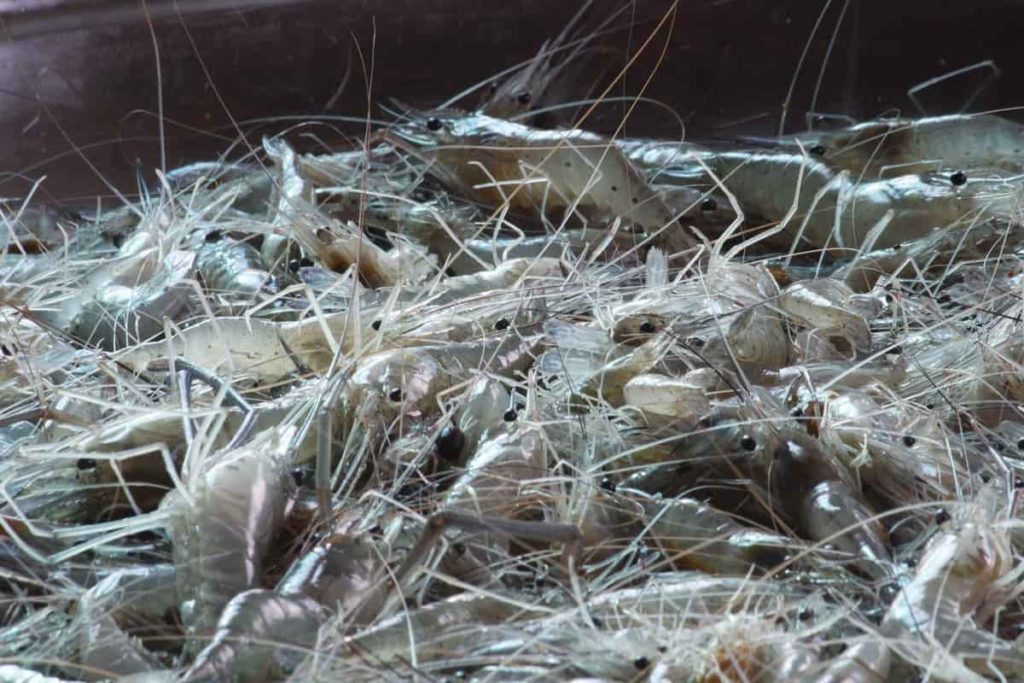
Why is my shrimp dying?
Smaller, more frequent water changes are much better than large changes. You should slowly drip new water into the aquarium. If you do water changes too quickly, you can shock the shrimp into prematurely molting, making them more vulnerable, which could lead to the death of your shrimp.
Things to consider in the shrimp farming business;
- First of all, starting a shrimp farming business requires an initial investment. And the specific requirement depends on the farm size and production output you need. So, you should be prepared for it.
- Shrimp variety plays an important role in the production and hence profitability. Therefore, choosing the right type is extremely important.
- Although the business does not demand a specific educational background, you should have some knowledge and skills. At least you should have 1 or 2 years of farm handling experience.
- Depending on where you live, you should consider farming techniques. If you live in coastal areas, shrimp farming is a profitable option. Alternatively, you can opt for pond culture or indoor shrimp farming in tanks.
Does shrimp need an air pump?
Also, air pumps should be used with medications when treating shrimp disease because most medications can reduce oxygen levels and impede oxygen exchange at the surface. So in such cases, an air pump is very much needed to help increase the amount of oxygen in the aquarium water. An air pump is a versatile aquarium accessory or equipment that provides a means by which a stream of bubbles enters the aquarium, thereby increasing water movement and circulation.
It is a mechanical device powered by electricity or a battery to pump air into the aquarium. The air produces moves from the pump to the aquarium using airline tubes such as air stones. Keep in mind that this device does not go inside the aquarium; it can either be placed on the side of the tank or placed in a cabinet; however, you need to connect it to the aquarium device (which will be placed inside the tank) using a suitable airline tubing.
An air pump works by forcing air into the water surface. The water surface is where gas exchange (oxygen and carbon dioxide transfer) occurs between water and air. Air pumps create many air bubbles that rise to the surface and pop, agitating the surface and breaking the surface tension.
Can I farm my shrimp?
People raise shrimp, in small tanks or large ponds at home, for their table or to sell as a seafood crop. Shrimp are popular aquarium additions, but they are also a popular cash crop. Shrimp prices have always been higher than other seafood. Buy young shrimp as a specialty retailer. Buy shrimp that are 30 to 60 days old to guarantee that you are getting healthy, wholesome shrimp.
Set up your shrimp tank. About 10 shrimp per 20 gallons of water gives the shrimp adequate personal space. Install a pump and filter system; line the aquarium with substrate and provide rocks and plants for the shrimp to hide. Turn on the pump, heater, and filter, and give the tank 24 hours to cure. Monitor the tank temperature and adjust the heater accordingly. Add the shrimp to the tank. Feed shrimp once a day and maintain water temperature and clarity. Shrimp will grow all summer and are ready to harvest in September or October.
In case you missed it: Making 60 Lakh Per Year from Prawn/Shrimp Farming – A Success Story of an Aqua Farmer
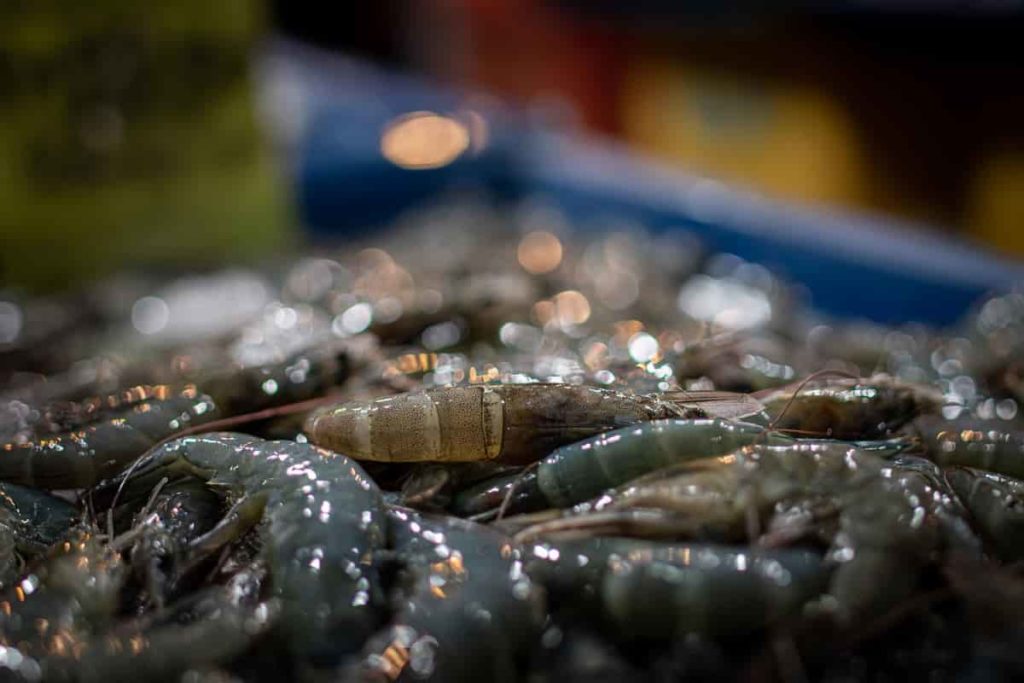
What are the advantages of shrimp farming?
- Shrimp farming is a profitable industry with many benefits for the farmers involved. One of the main advantages of shrimp farming is that it is a relatively low-risk venture.
- Shrimp are also easy to grow and grow quickly. It helps support the local economy by creating jobs in the community and generating income for businesses.
- Shrimp farming creates jobs and supports local economies by providing markets to local farmers and fishermen. It generates tax revenue for local governments.
- Also, it can help improve the environment by reducing deforestation and promoting sustainable practices.
- Finally, it provides an important source of protein for people in developing countries and can help reduce malnutrition rates in these areas.
What do shrimp need to survive?
Most shrimp require soft, low pH water. When shrimp farming emerged to meet the demand that outstripped the capacity of wild fisheries, old agricultural farming methods were quickly replaced by more productive methods needed to serve the global market. Industrial farming followed traditional methods at first, with so-called “extensive” farms compensating for low density with increasing pond size; Instead of ponds of only a few hectares, ponds of up to 100 hectares (1.0 km2) were used, and in some areas, large areas of mangroves were cleared.
Technological advances enabled more intensive practices that increased yields per area, helping to reduce the pressure to convert more land. Semi-intensive and intensive farms appeared, where shrimp were raised on artificial diets and ponds were actively managed. Although many extensive farms remain, the newer forms are usually semi-severe.
How are shrimp harvested?
- Most shrimp species can be harvested effectively by using a beignet placed in a sluice gate and catching the shrimp as they swim with the water flowing from the pond. The best time to do this type of harvest is on the night of the new moon or the full moon.
- From a farm management perspective, it is possible to take advantage of this compensatory growth through fractional harvesting strategies to increase production and profitability.
- Growth curves and feed rates for large shrimp under different production scenarios are needed to develop efficient harvesting models. Ultimately, farmers can use these models to increase production and improve profitability.
Can shrimp live in ponds?
People believe freshwater prawns are a good indicator of a polluted pond. They tolerate all types of pollutants so that they can live in good and bad ponds. Good quality ponds often contain shrimp, especially if the pond has been around for a while. Prepare your grow-out pond or pond. The ponds should be in an area that is not prone to flooding and should not be affected by runoff from pesticide application areas.
Ponds should have a depth of 2 to 5 feet and a surface area of 1 to 5 acres. Use skimmers, filters, and aerators to keep water quality at its best. Fertilizing the pond will ensure an abundance of natural food in the form of algae for the shrimp. The brackish water is pumped into the pond by a fine filtration system to 3-4 feet depth. Pond water is treated with minerals and probiotic yeast before storage.
What are the significant problems with shrimp farming?
The top three disease challenges in shrimp are WSSV (white spot syndrome virus), AHPND (acute hepatopancreatic necrosis disease), and EHP (Enterocytozoon hepatopenaei). In addition, the shrimp farming industry faces several challenges globally, the most important being various viral, bacterial, and fungal diseases; also, the need for additional new ingredients that will be needed to develop and support the growing demand for aqua feed; and the environmental impact, market, and investment issues.
Is indoor shrimp farming profitable?
- Power supply, nets, transport trucks, aerators, pumps, storage facilities, feed specification, and monitoring equipment, water quality testing equipment are required for indoor shrimp farming.
- Locate your pond in an area not prone to flooding and not affected by runoff from pesticide application areas. Use skimmers, filters, and aerators to maintain optimal water quality. Fertilizing the pond will help you provide plenty of natural food for the shrimp in the form of algae.
- The costs of starting indoor shrimp farming can be pocket friendly and relatively low. For example, a farm with 40 tanks, including building costs, can cost up to Rs 500,000.
In case you missed it: Organic Shrimp Farming – Prawn Production Practices
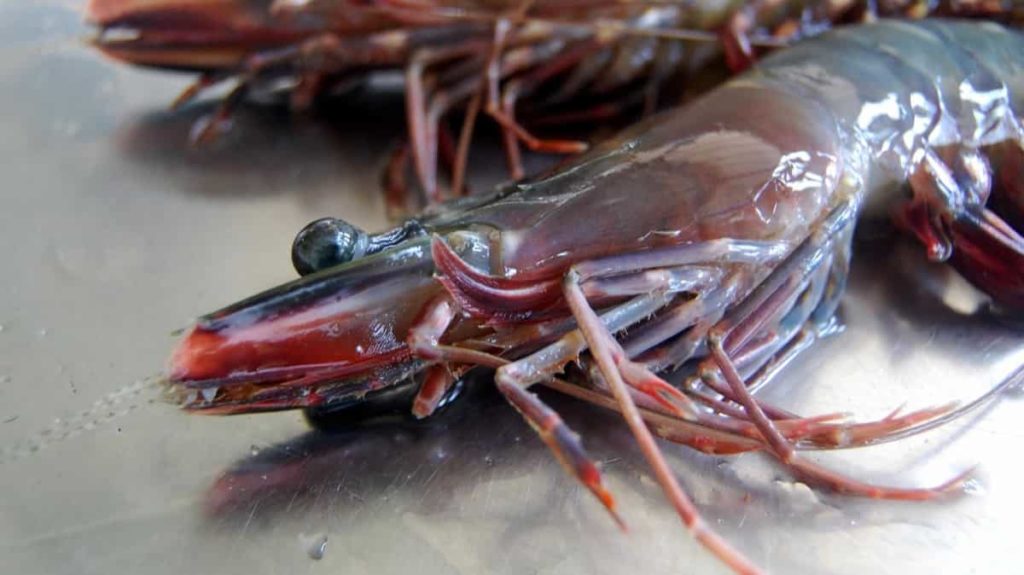
How long do farmed shrimp take to grow?
Shrimp are grown from juveniles to marketable size in grow-out ponds, which takes three to six months. Within a short period, you can get the harvest in good condition. Excessive contamination of shrimp with waste should be prevented by technique. Fast harvesting will certainly reduce the risk of bacterial contamination, and the prawns will remain fresh when they reach the processor.
How fast do shrimp reproduce?
- Although the entire breeding process usually takes three to five months, female shrimp can breed a few days again after hatching.
- Depending on the shrimp type you have and the overall environment of the tank, the breeding process can take three to five months.
How many shrimp are in a pond?
It is recommended to stock ten small shrimp per gallon of water. However, if some people are new to shrimp farming, it is recommended to only stock five shrimp per 1 gallon of water.
What size tank do shrimp need?
- Shrimp can be kept in aquariums for up to 5 gallons. However, 10 gallons size tank is more common and recommended.
- As with any aquarium, water will increase stability which is very important when caring for shrimp. Shrimp may be more sensitive than fish to changes in water quality.
What is the economic importance of shrimp?
In general, shrimp farming is most profitable when done on a large scale—generally, the larger the farm, the lower the production cost per kg of shrimp. However, even small-scale farms can be profitable if prices are high enough. Shrimp farming profitability also depends on the variety of shrimp. Some varieties are more expensive, and demand for different varieties can vary from season to season.
Can shrimp be farmed in freshwater?
Freshwater shrimp have grown from 1/10th of an acre to 5+ acres in earthen ponds. They are relatively easy for aquaculture but require large ponds with excellent filtration and water quality. Many shrimp farms have successfully used the three-pound system, allowing three harvests a year. Freshwater shrimp consume detritus, helping break down organic matter and convert it into material plants can use. The success of the freshwater shrimp farming business depends significantly on the quality of your pond.
What temperature do shrimp live in?
Keeping dwarf shrimp at normal room temperature, like your home is often kept at (20-23°C), is generally best for shrimp rearing and breeding.
How often do you feed shrimp?
- Shrimp keepers will feed their colonies every two or three days, depending on the age and conditions of the tank, etc. Well-aged tanks running for months usually have a decent amount of biofilm and algae, giving them plenty to graze on throughout the day.
- Artificial feeds come from specially formulated, granular pellets that disintegrate quickly. About 70 percent of such pellets are wasted, as they decay before the shrimp eat them. They are fed two to five times a day.
- Feeding can be done manually either from shore or using mechanized feeders distributed over the pond. The feed conversion rate (FCR), i.e., the feed required to produce a unit (e.g., one kilogram) of shrimp, is claimed by the industry to be around 1.2–2.0 in modern farms, but this is an optimal value. On older farms or in the most ponded conditions, the ratio can easily increase to 4:1. A lower FCR results in higher profitability for the farm.
How much money can you make selling shrimp?
The money you can make selling shrimp from a small home-based operation will depend on various factors. A large-scale shrimp farm can give you anywhere from 37% to 55% profit. However, remember that large-scale operations will have a higher profit margin than small-home operations. That said, the potential for a good return on your investment is very real, and it depends on various factors.
In case you missed it: Shrimp Aquaculture in India – A Full Guide
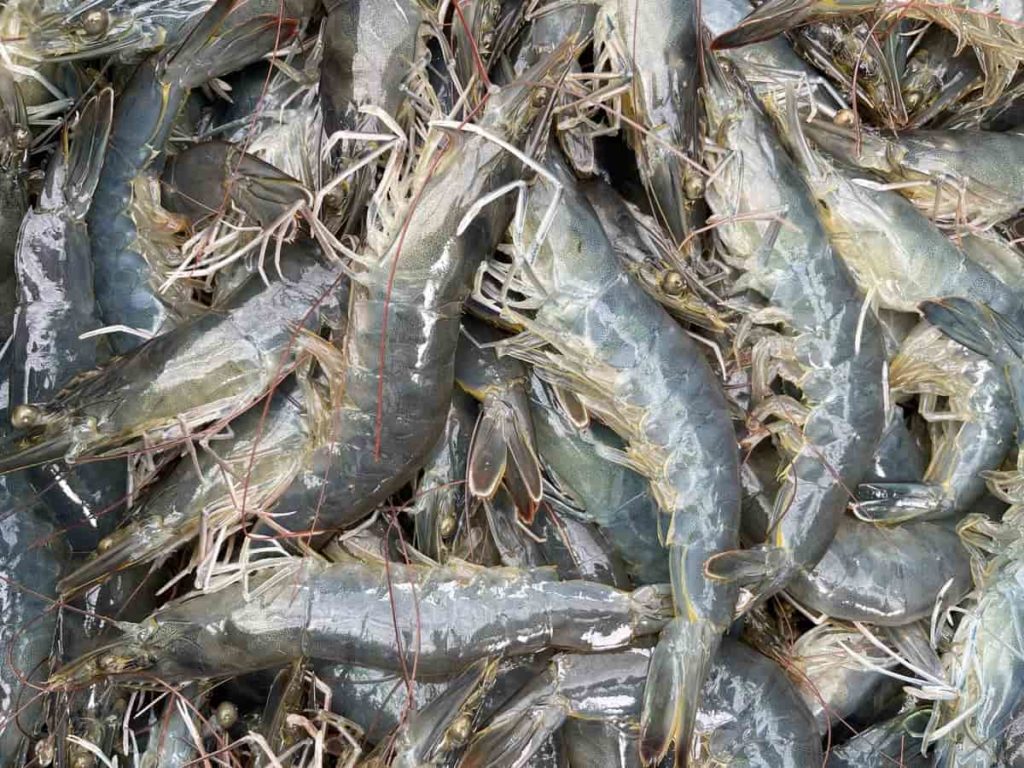
Why do shrimp survive during winter?
During the cold season, when temperatures drop, shrimp reduce their ability to catch prey, reduce digestion and reduce disease resistance.
What kind of water does shrimp live in?
- Depending on the species, shrimps are found in both warm and cold waters, from the tropics to the poles, and in fresh or salt water. However, only 23% of shrimp are freshwater species. Most shrimp are found near the bottom of the water they live in.
- Advanced shrimp are also more susceptible to disease due to poor water quality. So, it would help if you considered that higher shrimp grades might have higher mortality rates. It can affect your overall profit margin or require more effort and money to keep them alive.
How many shrimp should be kept together?
- When buying ten individual shrimp, please remember that they are social animals and do best in large groups of at least ten individuals.
- They tend to hide rather than graze as a group in the open.
How much cost is required to start a small shrimp farm?
- A small-scale shrimp farm with a 1-acre pond would need about $10,500 for these costs (excluding substrates).
- Sharing resources among multiple ponds reduces fixed costs per acre (e.g., $8,500 for a 1-acre two-pond farm, $7,891 for a 1-acre three-pond farm, etc.).
What do shrimp farmers feed their shrimp?
Farm-raised shrimp are increasingly fed diets made from soybean meal or plant-based products. However, they may be less attractive and palatable than feed animal food. Green foods such as Spinach and vegetables such as Squash or Zucchini are also suitable for feeding shrimp. In addition to the vegetable diet, shrimp also need a certain amount of protein so they do not attack young or weaker conspecifics.
Add brown dry autumn leaves from a deciduous tree to the aquarium to ensure your little crustaceans get everything they need. Tried and tested classic examples are beech, oak, hornbeam, etc. The foliage should be perfectly brown; above all, it must be completely dry. Although red, yellow, and green leaves look more decorative, they still contain traces of sugars the tree produces during photosynthesis. Therefore, they are not suitable as the main aquarium food.
How do you treat shrimp disease?
However, they are extremely common and in most cases, treatable. The first step in understanding and treating dwarf shrimp diseases and parasites is learning to recognize them. There are a variety of fatal viral diseases that affect shrimp. In crowded, monoculture farms, such virus infections spread rapidly and can wipe out entire shrimp populations. A major transfer vector for many of these viruses is water itself.
And thus, any virus outbreak threatens to wipe out wild shrimps. With their high mortality rates, diseases represent a real threat to shrimp farmers, who can lose income for an entire year if their ponds are infected. Since most diseases cannot yet be effectively treated, industry efforts are focused on preventing the spread of diseases. Active water quality management helps avoid pond conditions conducive to the spread of disease.
Rather than using larvae from wild catches, captive-raised specific pathogen-free brood stock and diseases are used in isolated environments and verified not to be used. To avoid introducing diseases to disease-free populations on a farm, there is also a tendency to create more controlled environments in farm ponds.
Conclusion
Shrimp farming is raising shrimp commercially in ponds, tanks, or raceways. Shrimp farming has since become a major aquaculture industry, providing income for thousands of people and a major source of seafood for millions of consumers. Therefore, the above are the best ways to start a shrimp farming business.
- Economical Aquaculture: A Guide to Low-Budget Fish Farming
- 15 Common Planting Errors That Can Doom Your Fruit Trees
- How to Make Houseplants Bushy: Effective Tips and Ideas
- Innovative Strategies for Boosting Coconut Pollination and Yield
- Pollination Strategies for Maximum Pumpkin Yield
- The Complete Guide to Chicken Fattening: Strategies for Maximum Growth
- Natural Solutions for Tulip Problems: 100% Effective Remedies for Leaf and Bulb-Related Issues
- Revolutionizing Citrus Preservation: Towards a Healthier, Greener Future
- Natural Solutions for Peony Leaf and Flower Problems: 100% Effective Remedies
- Maximizing Profits with Avocado Contract Farming in India: A Comprehensive Guide
- Natural Solutions for Hydrangea Problems: 100% Effective Remedies for Leaf and Flowers
- The Ultimate Guide to Choosing the Perfect Foliage Friend: Bringing Life Indoors
- From Sunlight to Sustainability: 15 Ways to Use Solar Technology in Agriculture
- The Ultimate Guide to Dong Tao Chicken: Exploring from History to Raising
- The Eco-Friendly Makeover: How to Convert Your Unused Swimming Pool into a Fish Pond
- Mastering the Art of Delaware Chicken Farming: Essentials for Healthy Backyard Flocks
- 20 Best Homemade Fertilizers for Money Plant: DIY Recipes and Application Methods
- How to Craft a Comprehensive Free-Range Chicken Farming Business Plan
- Brighten Your Flock: Raising Easter Egger Chickens for Beauty and Bounty
- How to Optimize Your Poultry Egg Farm Business Plan with These Strategies
- Subsidy for Spirulina Cultivation: How Indian Government Schemes Encouraging Spirulina Farmers
- Ultimate Guide to Raising Dominique Chickens: Breeding, Feeding, Egg-Production, and Care
- Mastering the Art of Raising Jersey Giant Chickens: Care, Feeding, and More
- Ultimate Guide to Raising Legbar Chickens: Breeding, Farming Practices, Diet, Egg-Production
- How to Raise Welsummer Chickens: A Comprehensive Guide for Beginners
- How to Protect Indoor Plants in Winter: A Comprehensive Guide
- Ultimate Guide to Grow Bag Gardening: Tips, Tricks, and Planting Ideas for Urban Gardeners
- Guide to Lotus Cultivation: How to Propagate, Plant, Grow, Care, Cost, and Profit
- Agriculture Drone Subsidy Scheme: Government Kisan Subsidy, License, and How to Apply Online
- Ultimate Guide to Raising Araucana Chickens: Breed Profile, Farming Economics, Diet, and Care
- Bringing Hydroponics to Classroom: Importance, Benefits of Learning for School Students
- Ultimate Guide to Raising Polish Chickens: Breed Profile, Farming Economics, Diet, and Care
- Ultimate Guide to Raising Australorp Chickens: Profile, Farming Economics, Egg Production, Diet, and Care
- Silkie Chicken Farming: Raising Practices, Varieties, Egg Production, Diet, and Care
- Sussex Chicken Farming: Raising Practices, Varieties, Egg Production, Diet and Care
- Homemade Feed Formulations for Livestock: Discover Cost-effective Starter to Finisher Feed Recipes
What do I need to get started with swimming pools